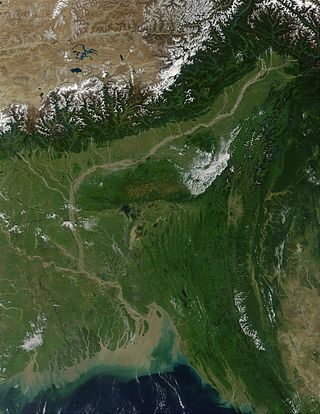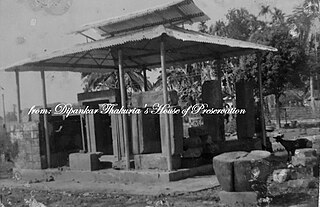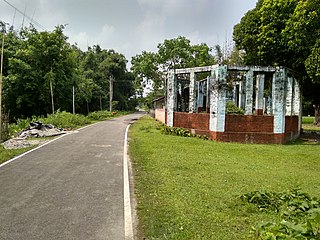Related Research Articles

Bongaigaon district (Prpn:ˈbɒŋgaɪˌgãʊ) is an administrative district in the state of Assam in northeastern India. The district headquarters are located at Bongaigaon. The district occupies an area of 1,093 km2.

Kamrup Rural district, or simply Kamrup district, is an administrative district in the state of Assam in India formed by dividing the old Kamrup district into two in the year 2003; other being Kamrup Metropolitan district, named after the region it constitutes. This district, along with Nalbari, Barpeta, Kamrup Metropolitan, Bajali and Baksa districts has been created from the Undivided Kamrup district.

The Dooars or Duars are the alluvial floodplains in eastern-northeastern India and southern Bhutan that lie south of the outer foothills of the Himalayas and north of the Brahmaputra River basin. This region is about 30 km (19 mi) wide and stretches over about 350 km (220 mi) from the Teesta River in West Bengal to the Dhansiri River in Udalguri district of Assam. The region forms the gateway to Bhutan. It is part of the Terai-Duar savanna and grasslands ecoregion.

Kamarupa, an early state during the Classical period on the Indian subcontinent, was the first historical kingdom of Assam.

The Kamata Kingdom emerged in western Kamarupa probably when Sandhya, a ruler of Kamarupanagara, moved his capital west to Kamatapur sometime after 1257 CE. Since it originated in the old seat of the Kamarupa kingdom, and since it covered most of the western parts of it, the kingdom is also sometimes called as Kamarupa-Kamata.

Goalpariya is a group of Indo-Aryan dialects spoken in the Goalpara region of Assam, India. Along with Kamrupi, they form the western group of Assamese dialects. The North Bengali dialect is situated to its west, amidst a number of Tibeto-Burman speech communities. The basic characteristic of the Goalpariya is that it is a composite one into which words of different concerns and regions have been amalgamated. Deshi people speak this language and there are around 20 lakhs people.

The Brahmaputra Valley is a region situated between hill ranges of the eastern and northeastern Himalayan range in Eastern India.

The Rabha people are a Tibeto-Burmese ethnic group who live mostly in the Northeast Indian state of Assam, with a lesser population in the adjacent state of West Bengal. They primarily inhabit the plains of Lower Assam and the Dooars, while some are found in the Garo Hills. Most of the Rabhas of Dooars refer to themselves as Rabha, but some of them often declare themselves as Kocha.

Chand Sadagar was an Indian sea merchant of Champaknagar in Eastern India. This merchant has been claimed by both the Assamese and Bengali people of India to be associated with their respective states and communities. Medieval Bengali poet Bipradas Pipilai mentioned in his "Manasamangal Kāvya" that merchant ship of Chand Sadagar used to proceed to the sea from ancient Champaknagar of Kamarupa after passing through Tribeni, situated at the junction of Saptagram and the confluence of Ganges, Saraswati and Jamuna River of modern-day West Bengal. Narayan Dev in the Assamese scriptures gave an account in his Manasamangal about the merchant ship of the trader Chand Saudagar proceeding to the sea from ancient Champaknagar of Assam passing through Saptagram and Tribeni, the tri-junction of the Ganges, Saraswati and Jamuna River. In the Padma Puran, account of Chand Bania (Sadagar) is specifically mentioned.

The Mech is an ethnic group belonging to the Bodo-Kachari group of peoples. It is one of the scheduled tribes of India, listed both in West Bengal and Assam, India. They inhabit West Bengal, Nepal, Assam and Nagaland.

The Koch are a small trans-border ethnic group of Assam and Meghalaya in India and northern Bangladesh. The group consists of nine matrilineal and strictly exogamous clans, with some of them preserving a hitherto sparsely documented Boro-Garo language called Koch, whereas others have switched to local varieties of Indo-Aryan languages. It is a Scheduled Tribe in Meghalaya, India. Koches want to preserve language and culture and heritage.
Rabha is a Sino-Tibetan language of Northeast India. The two dialects, Maituri and Rongdani, are divergent enough to cause problems in communication. According to U.V. Joseph, there are three dialects, viz. Róngdani or Róngdania, Mayturi or Mayturia and Songga or Kocha. Joseph writes that "the Kocha dialect, spoken along the northern bank of the Brahmaputra, is highly divergent and is not intelligible to a Róngdani or Mayturi speaker". Joseph also writes that "[t]he dialect variations between Róngdani and Mayturi, both of which are spoken on the southern bank of the Brahmaputra, in the Goalpara district of Assam and belong to the northern slopes of Meghalaya, are minimal". He concludes the paragraph on dialectal variation with: "The Róngdani-Mayturi dialectal differences become gradually more marked as one moves further west".

Kamrupi dialects are a group of regional dialects of Assamese, spoken in the Kamrup region. It formerly enjoyed prestige status. It is one of two western dialect groups of the Assamese language, the other being Goalpariya. Kamrupi is heterogeneous with three subdialects— Barpetia dialect, Nalbariya dialect and Palasbaria dialect.

Kamrup is the modern region situated between two rivers, the Manas and the Barnadi in Western Assam, with the same territorial extent as the Colonial and post-Colonial "Undivided Kamrup district". It was the capital region of two of the three dynasties of Kamarupa and Guwahati, the current political center of Assam, is situated here. It is characterized by its cultural artifacts.

KRNB lects are a cluster of modern lects that are phylogenetic descendants of the proto-Kamata language. The proto-Kamata language began differentiating after 1250 around Kamatapur, the capital city of Kamata kingdom, as the western branch of the proto-Kamarupa, whereas the eastern branch developed into proto-Assamese. Since the 16th century the proto-Kamta community has fragmented giving rise to the differentiated modern lects. The modern lects are: Kamta, Rangpuri (Bangladesh), Rajbanshi (Nepal) and Surjapuri (Bihar).

Undivided Kamrup district is a former administrative district located in Western Assam from which Kamrup Rural (2003), Kamrup Metropolitan (2003), Barpeta (1983), Nalbari (1985) and Baksa (2004) districts were formed. It was announced in January 2020 that the Bajali sub-division of Barpeta district will be upgraded to a full district.
The Regions of Assam are non-administrative units in the Indian state of Assam with a common historical past. Not all these regions are mutually exclusive.

The Undivided Goalpara district is an erstwhile district of Assam, India, first constituted by the British rulers of Colonial Assam.

Kamapitha is one of the four Kamarupa Pithas, the geographical divisions of ancient Kamarupa. Dineshchandra Sircar points out that these divisions are not found in the Kamarupa inscriptions and that they might be fabrications from late medieval sources, such as 16th-century work Yogini Tantra gives the boundaries of Kamapitha and other three pithas, the same work which gives boundaries of ancient Kamrup kingdom as well. The eastern border of Kamarupa was the temple of the goddess Tamreshvari near present-day Sadiya

Gohain Kamal Ali was an embanked road that connected the capital of the Koch dynasty, Cooch Behar in North Bengal to heart of Agomani in Dhubri and Narayanpur in Lakhimpur district in Assam, and ran along the foot of the Bhutan hills and the Dafla (Nishi) hills. This was constructed under the supervision of Gohain Kamal, the step-brother of the king, Nara Narayan and was completed in 1547. This was the road that the Koch general Chilarai used soon after for his invasion of the Ahom kingdom, and attacked the Ahom fort at Pichala, which was not a success, but a later movement in 1562 was greatly successful.
References
- Bannerjee, A C (1992). "Chapter 1: The New Regime, 1826-31". In Barpujari, H K (ed.). The Comprehensive History of Assam: Modern Period. Vol. IV. Guwahati: Publication Board, Assam. pp. 1–43.
- Dutta, Birendranath (1995). A Study of the Folk Culture of the Goalpara Region of Assam. Guwahati, Assam: University Publication Department, Gauhati University.
- Gait, Edward A (1906), A History of Assam, Calcutta, ISBN 9780404168193
{{citation}}: CS1 maint: location missing publisher (link)